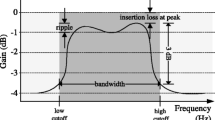Abstract
In this paper, a doppler distortion compensation method for underwater transmission of OFDM (Orthogonal Frequency Division Multiplexing) signals is proposed, which is used to realize real-time underwater acoustic communication between high-speed UUV (Unmanned Underwater Vehicle) and intelligent nodes. The method decomposes channel variations based on a functions with a set of known equations. OFDM symbol reconstruction is performed after the Taylor(T) FFT (Fast Fourier Transformation) process. We design an adaptive stochastic gradient descent algorithm based on MMSE criterion to learn the combiner weights for differentially coherent detection, thereby achieving adaptive channel equalization in the underwater acoustic channel. Comprehensive data and experimental data from the recent mobile acoustic communication delta are used to demonstrate the feasibility of this approach. The method can realize high-speed underwater acoustic communication, provide data sample basis for long-term big data analysis, and realize real-time communication result analysis.











Similar content being viewed by others
References
Bharati PV, Rao SK, Krishna AR (2013) Generation and analysis of tactics for anti-torpedo defense system. Information & Communication Technologies:382–387
Liu T, Guan Y, Lin Y (2017) Research on modulation recognition with ensemble learning. EURASIP J Wirel Commun Netw (1):179
Gui G, Huang H, Song Y, Sari H (2018) An Effective NOMA Scheme based on Deep Learning. IEEE Trans Veh Technol 67(9):8440–8450
Liu S, Fu W, He L et al (2017) Distribution of primary additional errors in fractal encoding method. Multimed Tools Appl 76(4):5787–5802
Liu S, Pan Z, Fu W, Cheng X (2017) Fractal generation method based on asymptote family of generalized Mandelbrot set and its application. Journal of Nonlinear Sciences and Applications 10(3):1148–1161
Lin Y, Zhu X, Zheng Z et al (2017) The individual identification method of wireless device based on dimensionality reduction and machine learning. J Supercomput (5):1–18. https://doi.org/10.1007/s1122701722162
Sun J, Wang W, Kou L, Lin Y, Zhang L, Da Q et al (2017) A data authentication scheme for UAV ad hoc network communication. J Supercomput (8):1–16
Song H, Rawat D, Jeschke S, Brecher C (2016) Cyber-Physical Systems: Foundations, Principles and Applications. Academic Press, Boston
Lin Y, Wang C, Wang J, Dou Z (2016) A Novel Dynamic Spectrum Access Framework Based on Reinforcement Learning for Cognitive Radio Sensor Networks. Sensors 16(10):1–22. https://doi.org/10.3390/s16101675
Lin Y, Wang C, Ma C, Dou Z, Ma X (2016) A new combination method for multisensor conflict information. J Supercomput 72(7):1–17
Tang B, Tu Y, Zhang S, Lin Y (2018) Digital signal modulation classification with data augmentation using generative adversarial nets in cognitive radio networks. IEEE Access 99:1
Wang H, Guo L, Dou Z, Lin Y (2018) A new method of cognitive signal recognition based on hybrid information entropy and d-s evidence theory. Mobile Networks & Applications (4):1–9
Lin Y, Li Y, Yin X, Dou Z (2018) Multisensor fault diagnosis modeling based on the evidence theory. IEEE Trans Reliab:99, 1–99, 9
Wu Q, Li Y, Lin Y (2016) The application of nonlocal total variation in image denoising for mobile transmission. Multimed Tools Appl 76(16):1–13
Wang H, Li J, Guo L, Dou Z, Lin Y, Zhou R (2017) Fractal complexity-based feature extraction algorithm of communication signals. Fractals-complex Geometry Patterns & Scaling in. Nature & Society 25(5):1740008
Liao J, Qiao G, Ma X (2014) A novel parallel interference cancellation scheme for OFDM in time-varying underwater acoustic channels. In: International Conference on Mechatronic Sciences, Electric Engineering and Computer, pp 3692–3696
Wang Z, Song H, Watkins DW et al (2015) Cyber-physical systems for water sustainability: challenges and opportunities. IEEE Commun Mag 53(5):216–222
Aval YM, Stojanovic M (2015) Differentially coherent multichannel detection of acoustic ofdm signals. IEEE J Ocean Eng 40(2):251–268
Gang Q, Babar Z, Lu M, Lei W, Xin Q, Xue L et al (2018) Shallow water acoustic channel modeling and MIMO-OFDM simulations. International Bhurban Conference on Applied Sciences and Technology:709–715
Ma X, Zhao CH, Qiao G (2009) The Underwater Acoustic MIMO OFDM System Channel Equalizer Basing on Independent Component Analysis. Wri International Conference on Communications and Mobile Computing:568–572
Effect WAG (2014) The nonlocal sparse reconstruction algorithm by similarity measurement with shear let feature vector. Math Probl Eng 2014:1): 1–1): 8
Yerramalli S, Stojanovic M, Mitra U (2012) Partial fft demodulation: a detection method for highly doppler distorted ofdm systems. IEEE Trans Signal Process 60(11):5906–5918
Ma X, Wang T, Lin Y et al (2012) Parallel Iterative Intercarrier Interference Cancellation in Underwater Acoustic Orthogonal Frequency Division Multiplexing. Wirel Pers Commun 2018(5):1–14
Ma X, Zheng C (2016) Decision fractional fast fourier transform doppler compensation in underwater acoustic orthogonal frequency division multiplexing. J Acoust Soc Am 140(5):EL429
Shi C, Dou Z, Lin Y, Li W (2018) Dynamic threshold-setting for rf-powered cognitive radio networks in non-gaussian noise. Physical Communication 27
Wang X, Liu KJR (2002) An adaptive channel estimation algorithm using time-frequency polynomial model for ofdm with fading multipath channels. Eurasip Journal on Advances in Signal Processing 2002(8):1–13
Wang T, Proakis J. G, Zeidler J. R (2005) Techniques for suppression of intercarrier interference in ofdm systems. Wireless Communications & Networking Conference
Funding
This work is supported in part by the Open fund of state key laboratory of underwater information and control (6142218061812), Key fund for equipment pre-research (61404150301), Open project of key laboratory of underwater acoustic communication and Marine information technology (UAC201804) and Natural Science Foundation of Heilongjiang Province (LH2019A006).
Author information
Authors and Affiliations
Corresponding author
Additional information
Publisher’s Note
Springer Nature remains neutral with regard to jurisdictional claims in published maps and institutional affiliations.
Rights and permissions
About this article
Cite this article
Ma, X., Wang, B., Li, L. et al. A Communication Method between High-speed UUV and Distributed Intelligent Nodes. Mobile Netw Appl 25, 1528–1536 (2020). https://doi.org/10.1007/s11036-019-01357-w
Published:
Issue Date:
DOI: https://doi.org/10.1007/s11036-019-01357-w




